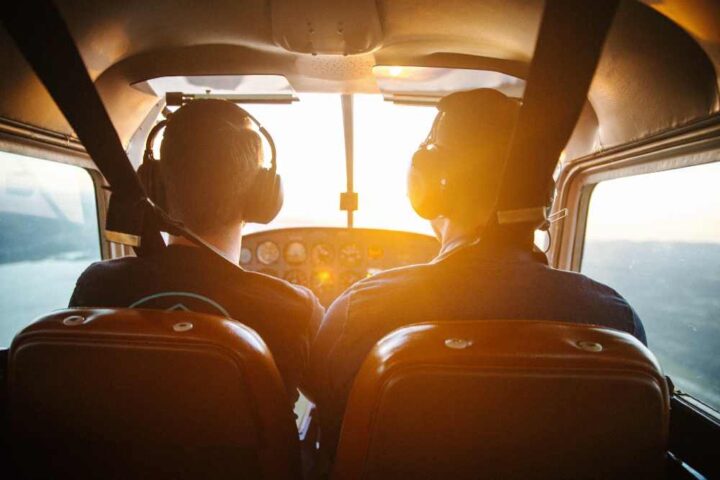Navigating the Regulations: Understanding the Requirements of a Private Pilot Course
Embarking on the path to becoming a pilot is an exhilarating adventure, filled with the joy of soaring through the skies and the chance to explore horizons. However, before taking flight, it’s crucial to understand the regulations governing pilot training. In this guide, we aim to shed light on the requirements of a pilot course providing insights for those who aspire to take to the skies.

1. The Fundamentals of Becoming a Private Pilot
Before diving into the prerequisites, let’s start with the basics of becoming a pilot. A pilot’s license (PPL) grants individuals permission to fly commercial aircraft for recreational purposes. Essentially, private pilots are not permitted to engage in flights or accept payment for their services.
To embark on your journey as a pilot, you generally need to be at least 17 years old in most countries (16 years old in some cases). Additionally, you must possess reading, speaking, writing, and comprehension skills in English per the International Civil Aviation Organization (ICAO) standards.
2. Aeronautical Knowledge; Ground Based Training
One aspect of a private pilot course involves establishing a solid foundation in aeronautical knowledge. Ground-based training encompasses a range of topics, including aerodynamics, aviation weather, navigation techniques, aircraft systems and operations, aviation regulations, and flight planning.
Demonstrating this knowledge during examinations, such as written tests conducted by aviation authorities, necessitates students to allocate time for studying from reliable sources approved by regulatory bodies. By grasping these principles, future pilots gain the ability to make informed decisions while operating an aircraft.
3. Flight Training: Practical Lessons
In addition to a foundation, practical flight training plays a crucial role in obtaining a Private Pilot License (PPL). These hands-on lessons foster the development of skills required for piloting. Aspiring pilots undergo flight lessons under the guidance of certified instructors who assist them through stages of flight training.
During these flight training sessions, students acquire proficiency in flight inspections, cockpit procedures, maneuvering an aircraft in different flight conditions, emergency protocols, communication with air traffic control (ATC) navigation techniques, and executing landing approaches. The number of required flight hours may vary across countries. Typically falls within the range of 40 to 70 hours.
4. Medical Fitness Requirements
Ensuring the safety of both pilots and passengers is paramount in pilot training. Therefore, maintaining fitness is a vital aspect. Pilots must possess an aviation certificate issued by certified aviation medical examiners.
The medical examination evaluates factors such as hearing ability, heart health, neurological functioning, mental well-being, and substance use. Maintaining a fit lifestyle and regularly monitoring any changes that may affect one’s fitness is crucial.
5. Endorsement for Solo Flights and Experience in Cross Country Flying
As students progress through their flight training and acquire the skills, their instructors provide endorsements for them to fly solo. This significant achievement allows aspiring pilots to take charge of an aircraft without their instructor present.
Aspiring pilots are also required to complete country flights to prepare for real-world situations beyond areas. These flights require skills in planning to select waypoints, consider weather conditions, accurately calculate fuel requirements along the route, and adhere to airspace regulations.
6. Practical Examination: The Checkride
The culmination of the pilot course entails undertaking a test known as a “check-ride.” This comprehensive evaluation assesses the knowledge and skills acquired during ground-based training and flight lessons.
During a check-ride evaluation conducted by authorized examiners from aviation authorities or regulatory organizations such as the FAA (Federal Aviation Administration) in the United States or Transport Canada Civil Aviation (TCCA) in Canada, participants demonstrate their flying skills. They showcase takeoffs and landings and precise control over maneuvers specified in aviator manuals.
7. Maintaining Proficiency: Staying Current as a Private Pilot
Obtaining a pilot license is the beginning of an ongoing journey characterized by continuous skill development and learning. It is crucial to stay updated with aviation regulations, advancements in aircraft technologies, and emerging trends in aviator and runway safety.
To retain their privileges as pilots, individuals must also meet recency requirements. This includes engaging in flight operations within a designated timeframe and keeping up with certification standards.
Conclusion
Becoming a pilot demands dedication, commitment, and comprehension of the associated requirements. By following the path of ground-based training, flight instructor with practical lessons, medical fitness assessments, solo flights, and successfully completing a check-ride evaluation, aspiring pilots can embark on an adventure among the clouds. It’s important to prioritize safety throughout this journey toward obtaining a private pilot status.


